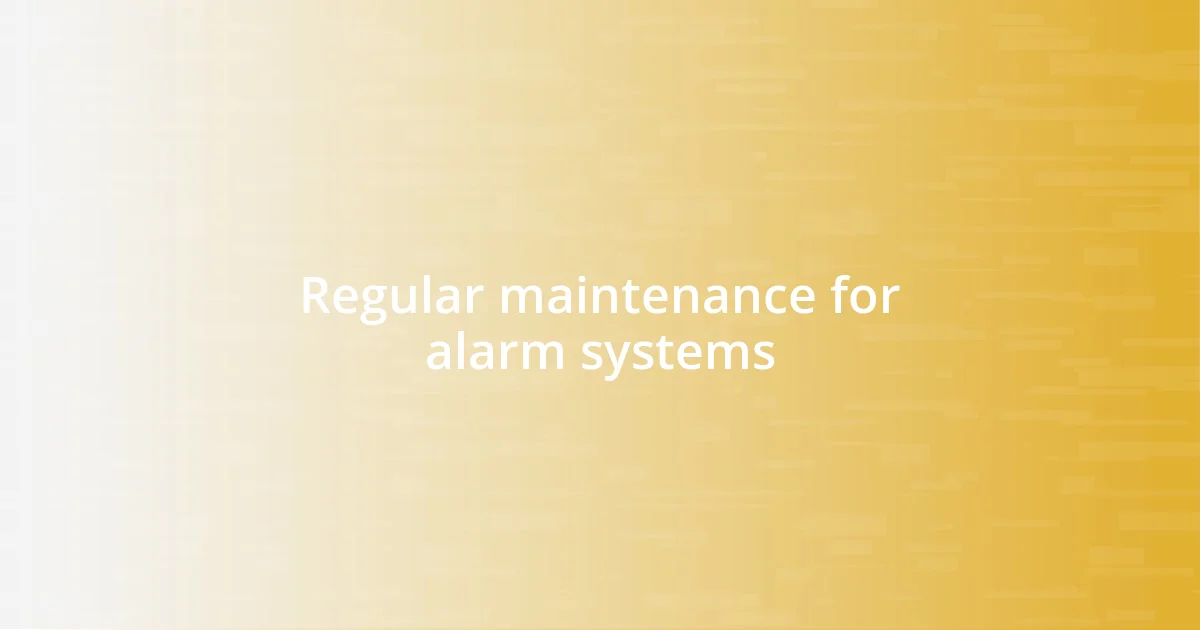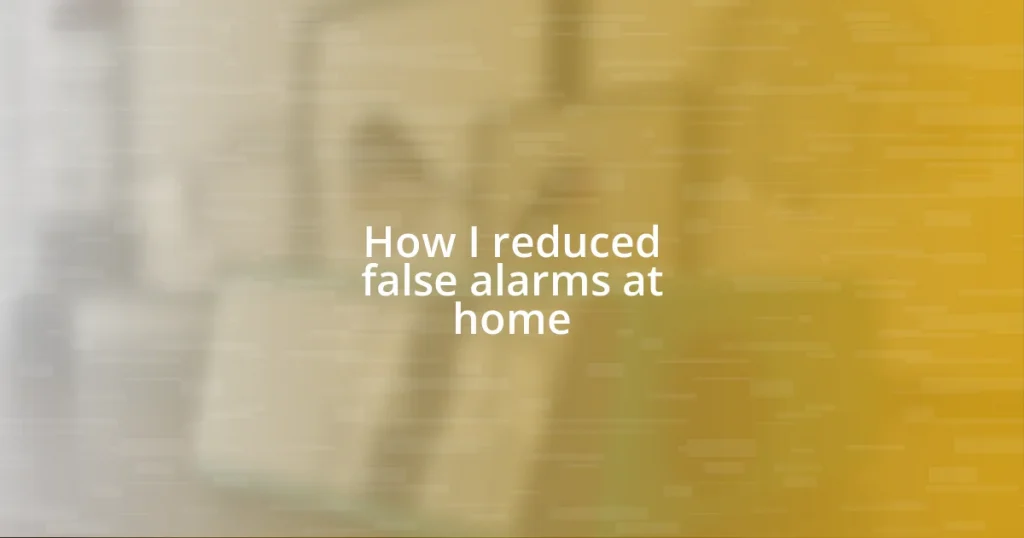Key takeaways:
- Common causes of false alarms include pets, environmental changes, equipment malfunctions, improper installation, and user error.
- Reducing false alarms is essential for maintaining a secure home, minimizing stress, and avoiding financial penalties from unnecessary emergency responses.
- Regular assessment and maintenance of alarm systems—such as adjusting sensitivity and proper placement—can prevent false alerts and enhance overall security.

Understanding false alarms at home
False alarms at home can be both frustrating and alarming—in more ways than one. I remember the first time our smoke detector went off due to burnt toast. My heart raced as I scrambled to the kitchen, only to find a perfectly edible breakfast and an obnoxiously blaring alarm as the result of a tiny mistake. It made me wonder: how often are we conditioned to react to situations that don’t really demand our immediate adrenaline response?
Understanding why false alarms occur reveals a deeper layer of our home security challenges. In my experience, common culprits include pets, changes in the environment, or simply equipment malfunction. The constant noise not only disrupts our peace but can also dilute our response to real threats. Have you ever thought about how many times your heart has skipped a beat only to discover it was just a passing car triggering your motion sensor?
Moreover, false alarms can lead to complacency. Once, after multiple false alarms from our security system, I found myself rolling my eyes at another “burglary alert.” The emotional toll can be overwhelming, as concerns turn from safety to annoyance. It’s crucial to recognize that while our systems are designed to protect us, they can inadvertently become sources of stress if not managed properly.

Common causes of false alarms
When I first installed my motion detector, I envisioned a secure home; instead, I was greeted with a barrage of false alarms. The culprit? My young kids racing through the living room, unwittingly triggering the sensor. Each time the alarm blared, my heart would leap, only to be met with giggles and a shiny toy in their hand. It’s remarkable how minor movements can set off these devices, and it became clear that understanding the triggers was essential to reducing these disturbances.
Here are some common causes of false alarms:
- Pets: Animals can unknowingly trip motion sensors, causing unwanted alerts.
- Environmental Changes: Sudden weather changes, like wind or rain, can impact sensor sensitivity.
- Equipment Malfunction: Aging or faulty equipment may send erratic signals.
- Improper Installation: If sensors aren’t positioned correctly, they might activate too easily.
- User Error: Accidental activation during routine tasks can lead to unnecessary alarms.
I’ve learned that being proactive about these causes can create a calmer home environment, allowing us to focus on genuine threats rather than misinformation from our devices.

Importance of reducing false alarms
Reducing false alarms is vital for maintaining a secure and stress-free home environment. I can’t stress enough how annoying it feels when an alert interrupts a peaceful evening, only to discover it’s a harmless shadow. This constant interruption gradually numbs our reactions to actual emergencies. Have you found yourself glancing at your phone, only to sigh in exasperation at yet another notification from the security system?
Moreover, the financial implications of frequent false alarms can’t be ignored. When emergency services are dispatched unnecessarily, it can lead to fines and increased insurance premiums. I once faced a hefty fee because a false alarm triggered a police response after I forgot to disable the system while letting my dog out. It made me realize how crucial it is to minimize these preventable occurrences for both our wallets and peace of mind.
Ultimately, creating an environment with fewer false alarms fosters a sense of trust and security in our home systems. When I managed to adjust the sensitivity of my sensors and re-evaluate their placement, I felt a weight lift off my shoulders. Fewer false alarms meant my family felt more secure, knowing our alarms would actually respond to genuine threats rather than everyday happenings.
| Advantages of Reducing False Alarms | Disadvantages of Not Reducing False Alarms |
|---|---|
| Increased safety and peace of mind | Heightened anxiety over false alerts |
| Lowered emergency response costs | Potential fines from false dispatches |
| More reliable home security | Desensitization to real threats |

Steps to assess your system
Assessing your home security system is a crucial step in reducing false alarms. Start by evaluating the placement of your motion detectors – I realized that the one near the window often picked up the swaying branches outside. This simple fix not only decreased the alerts but also saved me from constant anxiety over potential intrusions.
Next, take the time to review your system’s sensitivity settings. I remember when my sensors went off just because my teenage son walked through the hallway too quickly. After adjusting the sensitivity, we experienced a noticeable drop in unnecessary alerts. It’s fascinating how fine-tuning these settings can drastically improve your overall experience with the system.
Lastly, consider your home’s unique environmental factors. I’ve learned that factors such as heating vents or pets can trigger alarms, so observing how your system reacts to daily life can yield valuable insights. Have you ever noticed your system detecting shadows or reflections when the sunlight hits just right? By identifying and addressing these nuances, the system can work more effectively, leaving you with peace of mind as you go about your daily routine.

Best practices for alarm placement
When it comes to alarm placement, positioning is everything. I learned this the hard way when I installed a camera right above my front door. It seemed like a great idea until I realized it captured every leaf that fell and every passing car, flooding my phone with alerts. Placing it a bit higher and angled differently dramatically cut down on those unnecessary notifications—who knew that a small adjustment could make such a difference?
Another essential practice is to avoid placing alarms near common disruptions. For instance, I found out that my motion sensor was near a heating vent, which frequently triggered false alarms during the chilly months. It’s all about considering your home’s architecture and daily activities. Have you thought about how your pets or even curtains that move with the wind could impact your alarm system? Identifying these potential distractions can significantly bolster your system’s reliability.
Lastly, think about your home’s layout. In my case, I had a sensor in a narrow hallway that would go off whenever my kids dashed past while playing tag. After relocating it to a more open area, I noticed not just fewer alerts, but it also became more efficient at catching any actual intruders. Isn’t it refreshing to realize that optimizing your alarm placement can give you back those quiet, worry-free moments at home?

Regular maintenance for alarm systems
Maintaining an alarm system is like tending to a garden; regular upkeep makes all the difference. I often schedule monthly checks to ensure everything is functioning as it should. Just last month, I discovered a faulty battery in my smoke detector during one of these checks. Imagine the relief I felt knowing I acted before it failed during an actual emergency!
Another aspect I can’t stress enough is updating the software if your system supports it. There was a time when I ignored software updates, thinking, “What’s the worst that could happen?” But I quickly learned how critical these updates are in enhancing the system’s functionality and even fixing minor bugs that could lead to false alarms. Have you ever missed an important update because it seemed insignificant? Trust me, staying current makes a world of difference in system reliability.
Lastly, don’t overlook the importance of professional inspections. Hiring a technician for an annual checkup might seem unnecessary, but I found this practice invaluable. During one inspection, the technician discovered that some sensors weren’t aligned properly, leading to intermittent false alarms. That experience taught me that sometimes, an expert’s eye can catch what we might overlook in our everyday hustle. Isn’t it reassuring to know you’re safeguarded by a reliable system, fine-tuned to the nuances of your home?















